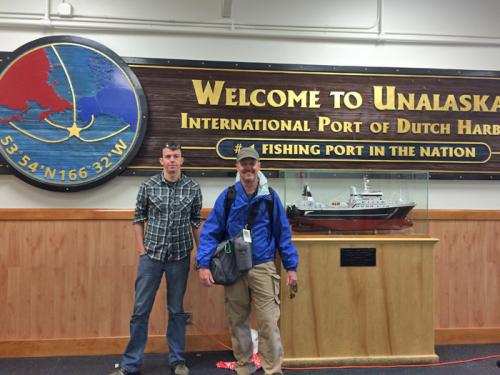GO DEEPER DISCUSSION: (see previous journal for the questions.)
We depart on our cruise from Dutch Harbor, which is about halfway out the Aleutian Island Chain, because it is the nearest deepwater port for the entire US Arctic. Since the Healy draws about 30 feet of water, it needs a deepwater port to tie up to when refueling and doing major loading or unloading. While this isn’t particularly convenient for Arctic Ocean access, it will allow us to do sampling stations in the Bering Sea, which is the body of water north of the Aleutian Islands and south of the Bering Strait.
TODAY'S JOURNAL:
Since I last wrote I’ve been traveling and helping out wherever I can aboard Healy. My flights went well, starting with a leg from Denver to Seattle and then on to Anchorage, Alaska. After meeting up with the aerosol sampling team and spending a pleasant overnight in Anchorage, we continued out to Dutch Harbor on a roughly 3-hour flight from Anchorage. The flights to Anchorage and to Dutch Harbor were both spectacular, with excellent views of glaciated mountains and remote coastlines. The final approach into Dutch Harbor was especially thrilling, as the twin-turboprop airplane sharply banked around the inside of an enclosing series of peaks surrounding Dutch Harbor to land on a runway right along the bay.
 As we flew out from Anchorage we crossed practically right over the glaciated Redoubt Volcano on the Alaska Peninsula.
As we flew out from Anchorage we crossed practically right over the glaciated Redoubt Volcano on the Alaska Peninsula.
 Bill Schmoker and Chris Marsay happy to make it on time & with all of their baggage in Dutch Harbor, Alaska.
Bill Schmoker and Chris Marsay happy to make it on time & with all of their baggage in Dutch Harbor, Alaska.
We had a few hours to settle in and do some exploring in Dutch Harbor the evening we arrived, but the next morning saw the beginning of concentrated activity aboard Healy. Today was again dedicated to unpacking, re-arranging, and moving stuff around. I’ve been mainly helping out in the holds, where different science teams are trying to find the gear that was stowed back in June so they can get their labs set up. The trick is that the holds were so tightly packed that to move something out from the middle, everything else in front needs to be put somewhere else. So there has been a lot of shifting of gear and moving large pallet boxes onto the elevator and up to another level or out onto the deck (sometimes just temporarily), like playing a big game of Tetris in order to get everything where it needs to be. I had the feeling sometimes over the last two days that I was an ant deep in the ant hill, working away to help the bigger cause.
 Walking up to Healy at dock in Dutch Harbor, Alaska, to undertake our first day of unpacking and organizing.
Walking up to Healy at dock in Dutch Harbor, Alaska, to undertake our first day of unpacking and organizing.
 Co-Chief Scientist Dr. William Landing contemplating the situation in Hold #3, two levels below the main science lab.
Co-Chief Scientist Dr. William Landing contemplating the situation in Hold #3, two levels below the main science lab.
Dutch Harbor itself seems kind of like a hive, with fishing vessels coming and going, flights in and out of the seaside airport, trucks ferrying shipping containers down to the dock where they are loaded onto large ships, etc. I saw another large icebreaker at dock this morning when I went to the Healy, but by the afternoon it had departed for the Arctic in support of oil exploration activities this summer. But there’s a tranquil side to Dutch Harbor, too- by just walking a few minutes along the coast you can put the bustle out of view and look out at verdant treeless hillsides, volcanic cliffs (often with an attendant Bald Eagle perched at the top) and a bay filled with spouting humpback whales and curious harbor seals. Yesterday after dinner I saw a sea otter lounging offshore and watched my first Horned Puffin of the trip cruse by like a football with wings.
 Breathtaking views abound in and around Dutch Harbor, including this view of Unalaska Bay just a few minutes from the front door of our hotel.
Breathtaking views abound in and around Dutch Harbor, including this view of Unalaska Bay just a few minutes from the front door of our hotel.
 Wildlife such as this Rock Sandpiper are part of the treasure hunt along Aleutian coastline.
Wildlife such as this Rock Sandpiper are part of the treasure hunt along Aleutian coastline.
GO DEEPER!
What landforms can you see being created by glacial erosion on Augustine Volcano? Many of these can be seen in mountains where glaciers retreated at the end of the last ice age, and to understand how they formed geologists study active glacial processes on mountains such as this.
That's all for now. Best- Bill

